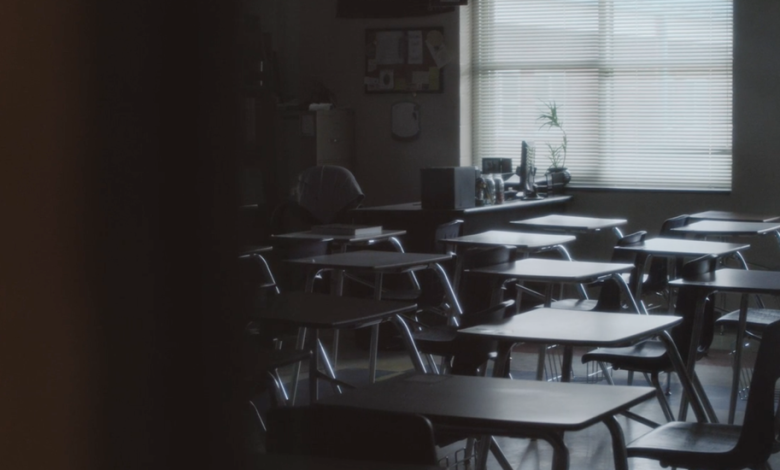Why Haven’t We Made It Safer to Breathe in Classrooms?

Two years ago, we got a chance to assure parents and teachers, in any future epidemic, that the air in classrooms was safer, making it easier for children to attend school in person and avoid learning loss and isolation.
In March 2021, Congress allocated $122 billion for schools to cope with the Covid pandemic and its aftermath — to hire tutors, retain teachers or improve their facilities. Public health and clean air advocates hoped that this would lead to widespread improvements in classroom ventilation and air quality, to help ward off future pathogenic threats and reduce problems like dust, allergens and wildfire smoke.
But only about 34 percent of school districts said they used any of the money to upgrade their heating ventilation and air conditioning systems, according to a recent survey from the Centers for Disease Control and Prevention. About 28 percent more installed in-room air cleaners, 8 percent said they installed ultraviolet lights — a more expensive and complicated method — and the rest reported no changes that would substantially improve air quality.
Moreover, once the federal spending was approved, aggressive salespeople descended on school officials who were struggling to open. School officials often were persuaded to spend more for products that many scientists believe aren’t substantially more effective than cheaper alternatives that have been thoroughly studied. Some of the products could even be dangerous.
Federal guidelines advised schools to draw more outdoor air into classrooms and use two thoroughly validated forms of filtration. But the guidelines often did not — and officials at the Environmental Protection Agency, the Centers for Disease Control and Prevention and the Department of Education told me they could not — warn against products that many experts believe were unproven, less effective, expensive or even potentially harmful. And while government websites sometimes advised school districts to research companies’ claims, overworked local officials were unlikely to be able to do that.
There was much money to be made. One company that sells air cleaning devices, ActivePure Technology, reportedly boasted in a job ad that its sales representatives had made “over six figures” in a single month by selling to a single school district.
It’s not entirely clear how much of that $122 billion is left to upgrade classroom air quality. But districts that still have money to spend must take advantage of this generational opportunity to protect schools not just from respiratory viruses like the coronavirus but also by reducing allergens and the burden of childhood asthma and even filtering out smoke from wildfires.
To do so, districts must avoid what has been done wrong in school systems across the country.
I interviewed dozens of independent scientists studying respiratory health whom I’ve known for years, and they all agreed that schools should primarily do two things.
One, bring more outside air into classrooms by opening windows (when the weather and outdoor pollution levels permit) or by adjusting heating and ventilation settings. This also lowers carbon dioxide levels, which can help students concentrate better and avoid headaches.

Linsey MarrCredit…Peter Means/Virginia Tech
Two, install filtering systems that can trap pathogens, allergens and pollutants rapidly and effectively. The scientists unanimously recommended filters with minimum efficiency reporting values of 13 or higher in centralized HVAC systems and high-efficiency particulate air (HEPA) filters for portable devices as necessary.
HEPA filters meet a Department of Energy standard, and their effectiveness has been thoroughly studied and validated for decades.
Minimum efficiency reporting value (MERV) is a measure of filtering effectiveness defined by the American Society of Heating, Refrigerating and Air-Conditioning Engineers, the industry’s trade organization. Many centralized HVAC systems are not designed to handle the highly efficient HEPA filters (rated MERV-17 or higher), but experts told me that MERV-13, which many systems can handle, goes a long way, especially if the air flows fast enough through the system.
A common standardized measure of filter performance is clean air delivery rate (known as CADR), which takes into account both the filtering efficiency and the rate at which air flows — the higher the rate, the more effective the filtration. A cheaper device with a higher rate can clean the air more effectively than an expensive one with a lower rating, no matter the slick marketing.
Figuring out which technology to use in schools should be simple, but it hasn’t always been easy, especially because of the influence of private companies.
After getting deluged by calls from sales representatives peddling various devices, Howard Taras, a medical consultant with the San Diego Unified School District, turned to scientists at the University of California at San Diego rather than take the companies’ claims at face value. He told me that Kimberly Prather, a professor of atmospheric chemistry at the university, where Taras is a faculty member, advised the school district to install MERV-13 filters in its centralized HVAC system and to add portable cleaners with HEPA filters to rooms where supplementation was needed. The district followed her advice, Taras told me. He said that many other school districts in the area, outmatched by the sales representatives, succumbed to the pitches and installed systems that did less.
Some school districts around the country, guided by scientists at nearby universities, constructed D.I.Y. portable filters using box fans, duct tape and MERV-13-rated filters, all of which can be purchased at hardware stores. These devices are called Corsi-Rosenthal boxes, after the engineers who designed them early in the pandemic: Richard Corsi, the dean of engineering at the University of California, Davis, and Jim Rosenthal. Multiple peer-reviewed studies show that the boxes can work just as well as, if not better than, many commercial HEPA filters, often at roughly a third of the cost.
Undergraduate students at the University of Connecticut built C-R boxes for less than $65 per unit, Marina Creed and Kristina Wagstrom, researchers at the university, told me. And in the Red Rock school district in Arizona, middle schoolers built the boxes, said Megan Jehn, an infectious disease epidemiologist at Arizona State University.
In contrast, New York City public schools, in addition to installing MERV-13 filters in HVAC systems and improving ventilation, bought more than 160,000 devices made by a company called Intellipure that were sold by a company called Delos Living. Gothamist reported that Delos Living paid hundreds of thousands of dollars for a firm to lobby city officials to buy the devices.
While the details of how the device works are not fully public, Intellipure says a “high energy field” in the device’s filter “clusters ultrafine particles to make them larger” and easier to capture. Delos Living says the devices “deactivate” trapped pathogens, which Intellipure says stops them from being released back into the room.
Intellipure’s website had claimed its devices work better than a HEPA filter because “anything smaller than 0.3 microns can get through” a HEPA device. This claim was removed from the website sometime after I asked about it.
Linsey Marr, an aerosol scientist and a professor at Virginia Tech, said it is “flat-out wrong” to imply that viruses were too small to be captured by HEPA filters. “HEPA filters,” she told me, “are good at removing all types and all sizes of particles in the air, including viruses,” echoing many other scientists who spoke with me.
She also said it was unnecessary to deactivate trapped pathogens to stop them from being released back into the room, and other scientists, including Jose Jimenez, an atmospheric scientist at the University of Colorado, agreed.
“Once things are trapped in the filter, they’re not coming back into the air, at least not easily,” Marr told me.
When asked about claims on the Intellipure website that a HEPA filter “has problems capturing viruses” because they are smaller than 0.3 microns — the E.P.A. says HEPA filters can remove 99.97 percent of particles at that size or greater — a Delos Living spokesperson conceded that a “HEPA filter is capable of removing particles smaller than 0.3 microns, which may include virus-sized particles.”
An Intellipure representative told me such particles “could pass through the filter” — but that’s like saying I could serve an ace against Rafael Nadal. When I asked about scientists’ objections to claims about deactivation, a Delos Living spokesperson agreed that once trapped, viruses “do not live long on a captured filter” but said it may matter for bacteria or mold. And a document Intellipure representative shared stated that “once an organism is captured by a HEPA filter, there is little chance of it being reaerosolized,” except when someone is “handling the used filters” — but Marr and Jimenez say a worker can simply wear an N95 mask while changing the filter.
More important, scientists, including Jimenez and Marr, say Intellipure’s clean air delivery rate is low, especially compared with options that don’t cost as much. The clean air delivery rate that the Delos Living representatives gave me for the devices’ highest (thus noisiest) setting is about one-fourth that of the quieter, much cheaper C-R boxes. New York City schools put two devices in each classroom to help meet C.D.C. guidelines.
The replacement filters for the Intellipure devices can be quite expensive. The New York City Department of Education recently used an emergency measure, which Gothamist said bypassed the regular approval process, to spend $27 million on replacement filters, paying about $137, including shipping, for each set — more than twice what I’d pay retail on filters for my home’s HEPA-based air cleaner.
Jenna Lyle, the deputy press secretary for New York City Public Schools, told me the district chose Intellipure because of its “competitive cost, overall device effectiveness and efficiency” and its ability to meet the large school district’s needs amid “supply chain disruptions,” emphasizing that the devices were an addition to the district’s fundamental upgrades.
Many scientists I spoke with were especially angry about another category of air cleaners widely sold to schools: additive air cleaning devices, some of which can introduce potential pollutants to the air while neutralizing or inactivating pathogens. The scientists say that their safety and effectiveness had not been studied enough, especially under real-life conditions, and that they are insufficiently regulated.
One chemical produced by many additive air cleaners is ozone, a lung irritant that is harmful to inhale, especially as concentrations go up. California strongly warns consumers not to use such devices. While many devices comply with an E.P.A. or California State standard that ensures ozone generation stays below a certain level under lab conditions, many scientists told me that is not sufficient to ensure safety in real-life conditions, especially in small spaces where such pollutant byproducts can accumulate over time.
Besides ozone, these devices can introduce many dangerous pollutants to the air, including volatile organic compounds like formaldehyde and acetaldehyde and other fine and ultrafine particulate matter, Jimenez told me. The E.P.A. links volatile organic compounds to a range of health effects, such as irritation, headaches, liver and kidney damage and potentially even cancer. Separately, particulate matter is a large killer in air pollution.
Yet many districts — Fort Worth, Atlanta and Memphis, to name a few — have bought and installed air purifiers that add ions, ozone or oxidizers to the air, despite a lack of sufficient peer-reviewed research demonstrating they are more effective than or even as effective as HEPA or MERV-13-rated filters at reducing the concentration of pathogens in the air. And the E.P.A. states that ionizers may be “relatively ineffective” in removing dust allergens or pollen, something HEPA and MERV-13 filters do well.
Scientists shared with me a spreadsheet with hundreds of examples of schools using various ionizers and other additive air cleaning technologies. In 2021 a Kaiser Health News investigation found more than 2,000 schools in 44 states had installed these types of technologies.
The E.P.A. warns that “ozone generating air cleaners can produce levels of this lung irritant significantly above levels thought harmful to human health” and notes “no controlled studies have confirmed” ion generators’ purported benefits. The E.P.A. also says needlepoint bipolar ionization, another type of additive air cleaning,“is an emerging technology, and little research is available that evaluates it outside of lab conditions” and warns about its potential to generate harmful byproducts indoors.
Scientists have questioned other devices districts are using.
The Philadelphia Independent School District spent $11.9 million on almost 14,000 devices with an air cleaning system from ActivePure Technology, which hired Dr. Deborah Birx, the Covid coordinator under Donald Trump, as chief medical adviser. Replacement filters will cost the district $2.3 million annually. After one replacement, the district will have spent about $1,000 per room for the devices.
An ActivePure representative told me that “the district’s decision to invest in ActivePure was and continues to be supported by a strong evidence base,” providing a single peer-reviewed article about the device’s effectiveness and safety. However, the company told me that the article was partly funded by distributors of ActivePure, and it tested a device that combined a HEPA filter and ActivePure technology. “It’s quite possible that they would have observed similar results with HEPA filtration alone,” Marr said.
The company says the device “creates molecules, which we call ActivePure molecules, that are then released back into the room” to reduce pathogens, although scientists say the way this technology works hasn’t been fully disclosed.
The ActivePure representative said its system used an “active” technology to neutralize pathogens, as opposed to “passive” technology like that in HEPA filters.
Jimenez called the company’s distinction “marketing gibberish. They use it to try to make filters look bad, since ‘passive’ doesn’t sound as good as ‘active.’ Doesn’t mean anything.”
Plus, many additive air cleaners aren’t as effective against wildfire smoke as HEPA filters are. Philadelphia schools recently had to go virtual when wildfire smoke seeped indoors.
When I asked district officials why they picked these products, they mentioned the company’s talking points, such as that HEPA and MERV-13 filters are passive, that it’s better for purifying to be active and that with HEPA and MERV-13 filters, the pathogens are not neutralized and are merely trapped in the filter.
Despite these concerns, guidelines from federal agencies do not clearly and emphatically tell school officials to skip expensive, unproven and potentially unsafe methods.
The main E.P.A. page on school air quality for the pandemic doesn’t explain the difference between filters, which take out only particles, and additive methods that potentially introduce pollutants and byproducts to the air.
The C.D.C.’s page on school air quality does suggest that schools “consider portable air cleaners” that use HEPA filters or UV lights but stops short of explicitly warning schools against more expensive, less proven technologies. A C.D.C. spokesperson told me it refrains from recommending for or against specific products but that its website notes ionization “can result in exposures to substances that may be harmful under certain circumstances” and “encourages consumers to ask questions and take precautions when considering the safety and effectiveness of emerging technologies.”
Perhaps the most explicit, clearest guidelines with specifics came from the White House, though they didn’t arrive until December 2022. They recommended drawing in more outside air using proven methods of filtration and comparing the clean air delivery rates of devices, explicitly said to avoid products that generate ozone and noted bipolar ionizers were not recommended at this time.
When I asked why guidelines had not been stronger earlier, representatives for the C.D.C., the E.P.A. and the Department of Education pointed out that they reached out to schools in webinars and opened up hotlines for them to ask questions, but they said that their agencies lacked the legal authority to recommend particular devices over others because of lack of regulatory authority.
In one frank conversation, a frustrated government official who asked not to be named because of the sensitivity of the controversy listed various outreach efforts to schools and states to try to steer them toward better choices but admitted that fell short of what was necessary and conceded that these companies had “out-hustled” the government.
As for regulating the claims by air cleaners that trouble scientists, a representative at the Consumer Product Safety Commission said that while it regulates some air cleaners as consumer products, those marketed with medical claims are regulated by the Food and Drug Administration. If they are intended for use by children, the commission shares jurisdiction with the F.D.A. Air cleaners that kill viruses or bacteria are pesticide devices, so the commission shares jurisdiction over those with the E.P.A. Air cleaners made for commercial or industrial use are regulated by the Occupational Safety and Health Administration.
“We have reached out to E.P.A. and OSHA, which may share jurisdiction in this matter, and are examining these claims,” a spokesperson for the commission said.
One reason the government took halting steps to protect classrooms was that public health agencies were late to acknowledge that Covid’s main form of transmission was airborne and the highest risk was in poorly ventilated indoor spaces.
There now need to be scientific standards on indoor air quality. HVAC systems and portable air cleaners should be subjected to strict safety regulations and meet standardized efficiency ratings, like the Energy Star ratings the E.P.A. and the Department of Energy set for home appliances.
The government should not allow the sale of any air quality systems or products that do not have sufficient reliable research backing up their claims, especially for additive air cleaning technologies, for which there’s a question not just of effectiveness but of safety.
The C.D.C. took a step this May when it recommended that ventilation systems should exchange air in rooms at least five times per hour. In October 2022, the Lancet Covid-19 Commission produced a report with recommendations on indoor air quality. The American Society of Heating, Refrigerating and Air-Conditioning Engineers also recently released new standards for better testing and standardization of air cleaners and indoor air quality devices and filters. But more action is needed.
Many big corporations know the importance of healthy indoor air. JPMorgan Chase designed its Midtown Manhattan headquarters with MERV-13 filters, real-time air quality monitors and a high rate of bringing in outside air.
Why should our children have any less?
The Times is committed to publishing a diversity of letters to the editor. We’d like to hear what you think about this or any of our articles. Here are some tips. And here’s our email: [email protected].
Follow The New York Times Opinion section on Facebook, Twitter (@NYTopinion) and Instagram.



